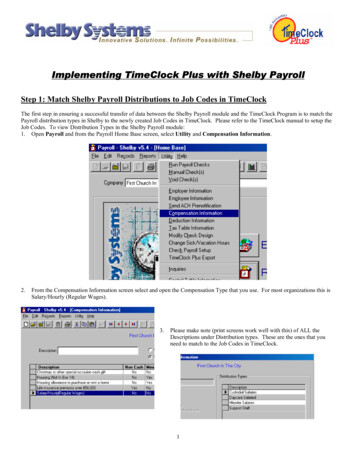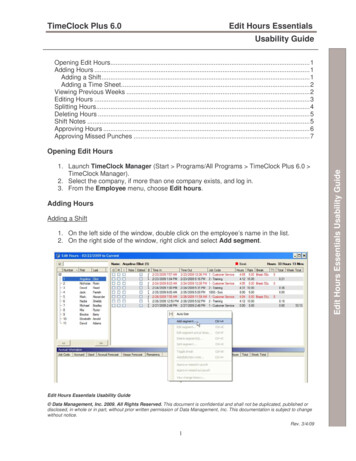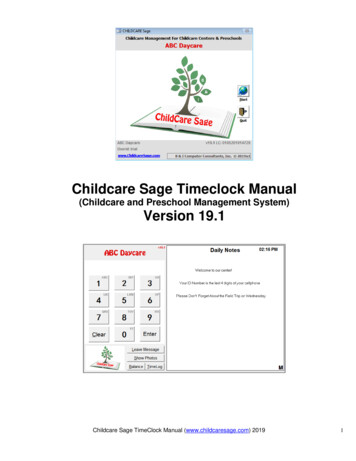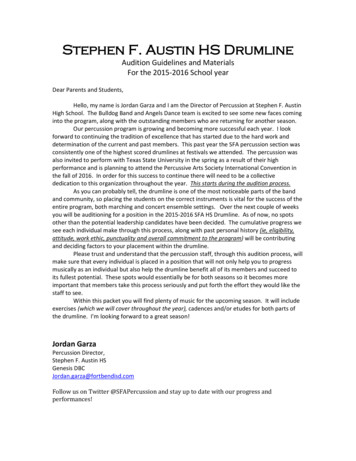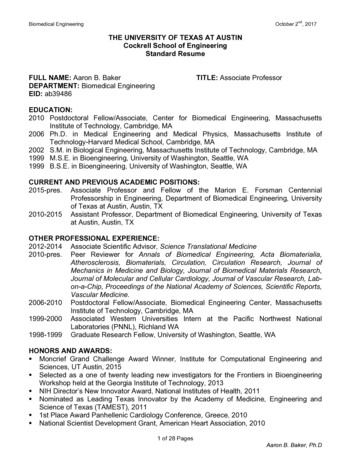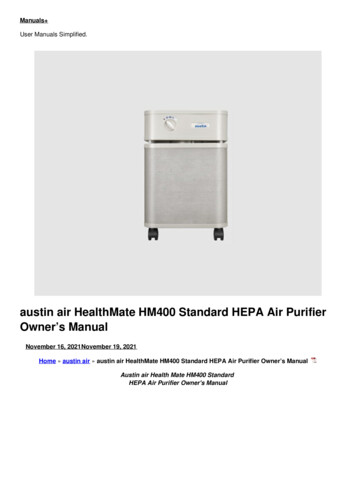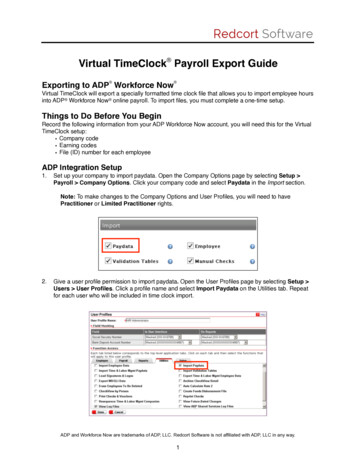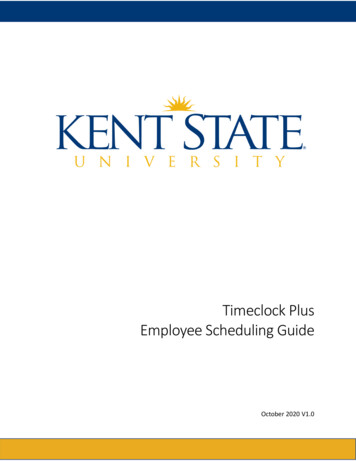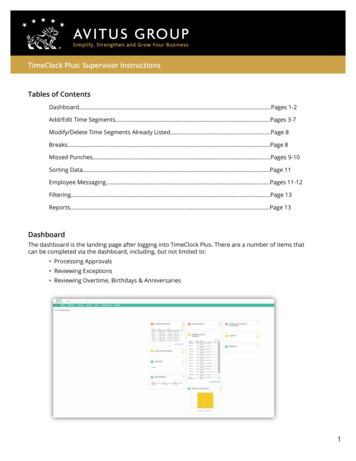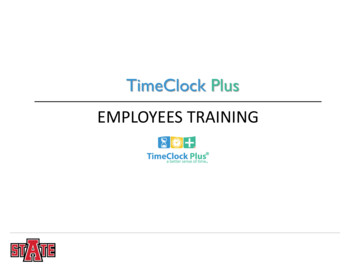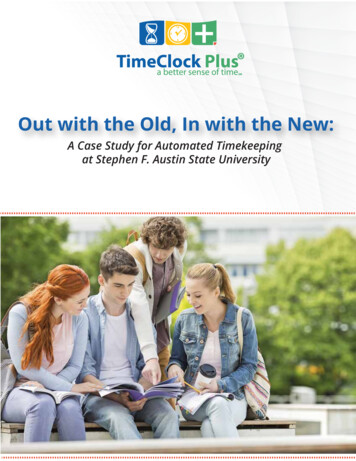
Transcription
Out with the Old, In with the New:A Case Study for Automated Timekeepingat Stephen F. Austin State University
Transitioning to Automated Time and Attendancewith Banner IntegrationStephen F. Austin State University, one of only four independent universities in the state of Texas, is dedicated toexcellence in teaching, research, creative work and service. The university began in 1923 as a teacher’s collegeand has grown to more than 120 majors and concentrations that lead to 80 undergraduate degrees, 40 master’sdegrees and 3 doctoral degrees.SFASU serves 12,801 students with the help of 3,400 employees working in 80 different departments, each withspecific needs for time tracking and reporting.“Our whole payroll process was labor intensive.”-Judy Duffin, Payroll ManagerThe previous process for payroll at SFASU was labor intensive and riddled with inefficiencies that hindered auditing, created opportunities for data entry error and resulted often in unnecessary comp time accrual.A Manual, Labor-IntensivePayroll WorkflowSFASU tracked employee hours in numerousways: some employees clocked in and out from amechanical time clock, some used papertimesheets and some departments kept up withall their employees’ time on departmentaltimesheets. Additionally, many employees werepaid on a commission basis, so compensationhad to be calculated based on that amountrather than a number of hours worked.The variety of processes used to accommodateSFASU’s numerous departments and their needsdid not easily lend itself to one simple reportingprocess; consequently, all departments had totransfer all of their employees’ time to universitymandated paper timesheets, forcing even thedepartments with automated systems to use thepaper forms. One large department on campusalready used a TimeClock Plus solution to gathertheir employees’ hours, but then had to transferthat data by hand to the university’s papertimesheets every pay period.“We needed to find a solution thatwould allow us to interface with ourERP system, eliminating the need toprint paper timesheets.”The departments were also sent a second set offorms for each pay period with current balancesand accruals for vacation and sick leave for everyemployee so that administrators could reportusage of vacation, sick and FLSA compensatorytime accrued and taken for the month.1
Because SFASU’s hourly employees were paidsemimonthly, the labor-intensive payroll processhad to be repeated twice each month. Theprocess began when time sheets and leavereports were sent to print by the payroll department, printed in the IT department and thenpicked up in the building next door by payrollpersonnel.“When our consultant informed us how Banner handles compensatorytime by paying the firsthour and banking the halfhour, we knew we neededto find a solution thatwould work the way wehandled it by banking FLSAcompensatory time at timeand a half.”These timesheets and reports were then separated by department, placed into envelopes andtaken to the post office for distribution bycampus mail to each timekeeping location.Finally, departments were required to submitpaper copies back to the payroll office by thedue date via campus mail.Though both timesheets and leave reports haddue dates printed on them, payroll consistentlyreceived late submissions from departments; asa result, many hours were spent each payrollcycle collecting the data from the various timekeeping methods, entering data into Banner byhand and processing these late timesheets insupplementary payrolls.Versatile and Cost EffectiveSolution NeededAd Hoc Reporting and BannerIntegration RequiredBSFASU needed to address the payroll processinefficiencies and procure a lasting solution thatwould maximize productivity and reduce unnecessary paperwork. SFASU needed software thatimproved the tracking of employee hours andprovided robust reporting for the departments.The system had to interface with SFASU’s existingBanner solution to eliminate the need for printedtimesheets and manual data entry.SFASU needed to unify their departments with an integrated, multi-faceted timekeeping system that took intoaccount the unique composition of the university workforce and would seamlessly integrate with existing softwareat a reasonable price.After research and deliberation, SFASU leadership eliminated timekeeping solutions that were cost prohibitive orlacked required flexibility, ultimately choosing TimeClockPlus as their solution. TCP was charged with ensuringSFASU could transition from a varied and inefficientprocess for timekeeping to an automated and efficient onethat would work campus-wide. The implementation of anew process across such a large and diverse campusmeant challenges were inevitable.Much of the work performed by the payroll officeeach month was to account for employee compensatory time earned, so the right timekeepingsolution also had to properly account for the waySFASU handled compensatory time - by bankingFLSA comp time at time and a half - instead ofthe way Banner accounted for the time- payingthe first hour and banking the remaining halfhour.For SFASU staff, their challenges included reluctant administrative staff, technology glitches and a long list of specificcalculation and interfacing requirements that wouldrequire some customized programming; however, change“It has been our experience that the employees at TimeClock Plus really careabout their customers and make every attempt to keep them happy.”2
was long overdue and the burgeoning university desperately needed to move the campus toward an automatedprocess more in keeping with a leader in academic excellence.The university was committed to making the transition successful and TCP was confident that SFASU’s desire for aunified system that interfaced with Banner was achievable.Once TimeClock Plus was brought on board, biometric readers were installed as needed, training of departmentalapprovers was completed, and the new process was put into action. A quick implementation began in July 2010 andthe new campus-wide timekeeping system was live by September 1, 2010.The first challenge came from some resistant staff members in several departments who were not accustomed toclocking their time and preferred to enter their time manually after the fact. After deliberation, SFASU administration decided to give departments the opportunity to decide for themselves how they would each record time fortheir employees with TimeClock Plus.With the flexibility granted by the administration, department heads could choose to make use of TCP’s timesheetoption, which provided a way for some employees to enter the hours they work each day instead of requiring themto clock in and out. Because TCP was able to give SFASU departments some additional options, support for theroll-out process was significantly improved.As the roll-out progressed, it became clear that the export/import processes needed additional tweaking to make itfunctional on a day-to-day basis for those who needed to complete exporting and importing tasks regularly. TCPprovided a project owner to help the system deliver results as expected and listened to the concerns of those affected to ensure a solution could be quickly implemented.“TimeClock Plus is now used at an enterprise level throughout Stephen F. AustinState University.”After the system worked in most areas as expected, SFASU still suffered from a few integration shortcomings thatkept them from working at an optimal level. Once, in an urgent situation, TCP chose to forgo the traditionaltelephone-based support in favor of deploying a team to the campus in Nacogdoches, Texas, to address the challenges with SFASU personnel. The TCP team took time to fully understand the integration challenges and resolvedmany issues on the spot. For any issues that couldn’t be resolved on-site, the team provided solutions to SFASUwithin a couple of days of being back in the office.3
Optimal Results AchievedThe immediate result of the implementation was a streamlined, automated process for payroll and leave reporting.Administrators could now edit time efficiently, saving hourson recordkeeping and auditing processes. SFASU werenow able to pay hourly employees based on the hoursworked, comp time accrued, or leave taken on asemi-monthly basis and report the leave usage and comptime earned accurately and in compliance with state andfederal reporting requirements for all employees subject toFLSA.The payroll office could also run more efficiently, proactively reviewing reports prior to paying as opposed to beingreactive when a department finds an error. Valuablesquare footage was opened up in the payroll office sincethe now automated process eliminated the need to retainpaper timesheets in bulky, heavy file cabinets.More than four and a half years later, SFASU is stillequipped with a timekeeping solution that continues togrow with the thriving institution. As it is now used at anenterprise level throughout the SFASU system, more than1,900 employee’s clock in and out each day across thecampus.SFASU staff believes that one of the greatest benefits ofthis new system is the flexibility allowed to individualdepartments, preserving their autonomy and providingthem with a system that isn’t one size fits all. Almost everySFASU department has staff recording time with TimeClockPlus. Some departments use physical time clocks, including two departments that use the fingerprint biometrictechnology and approximately 75% of all departments usethe timesheet function for their administrative assistants.No matter which method is utilized, a clear audit trail isalways available for staff to review time reporting foraccuracy.“After more than 4 1/2years of using TimeClockPlus, we still receive callsto find out how we aredoing and if we need anything.”For more than 26 years, TimeClock Plus has focused oninnovation in timekeeping with an unwavering commitmentto quality, never losing sight of the ultimate goal: userbenefit. TCP is committed to providing customer-focusedsolutions to the unique requirements and diverse workforce found in the world of higher education.Focus On: Stephen F. Austin State UniversityIndustry: Higher EducationEmployees: 3,000 Contact: Judy DuffinTitle: Payroll Manager4
Stephen F. Austin State University, one of only four independent universities in the state of Texas, is dedicated to excellence in teaching, research, creative work and service. The university began in 1923 as a teacher's college and has grown to more than 120 majors and concentrations that lead to 80 undergraduate degrees, 40 master's
